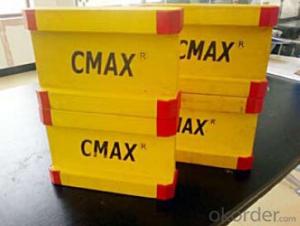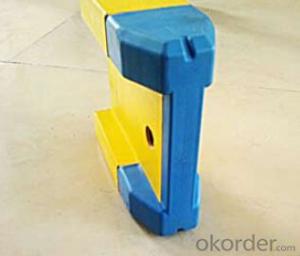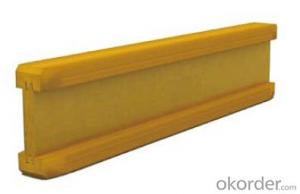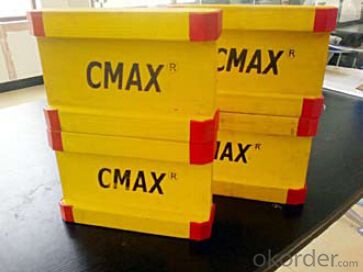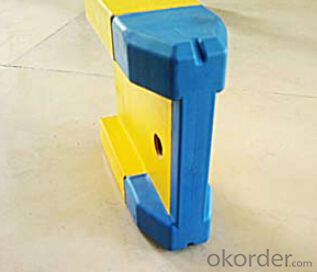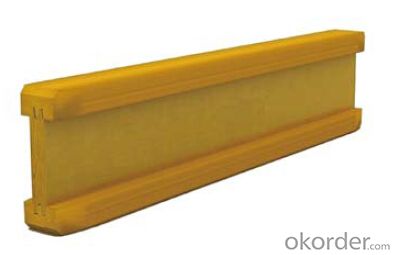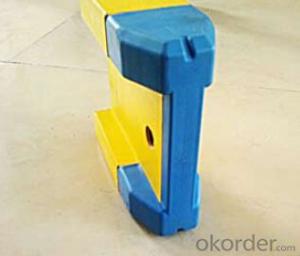Timber-Beam Formwork for building Construction
- Loading Port:
- Tianjin
- Payment Terms:
- TT OR LC
- Min Order Qty:
- 50 m²
- Supply Capability:
- 1000 m²/month
OKorder Service Pledge
Quality Product, Order Online Tracking, Timely Delivery
OKorder Financial Service
Credit Rating, Credit Services, Credit Purchasing
You Might Also Like
Plywood --- make perfect concrete surface
WISA-Form Birch is a coated special plywood using in the formwork systems where high
requirements are set on the concrete surface and the times of reuses.
With CNBM timber beam & WISA plywood, the formwork is low weight but high load capacity, it is
widely used in construction.
Characteristics:
◆ Component with high standardization.
◆ Assembling in site, flexible application.
◆ Light weight, easy transportation and storage.
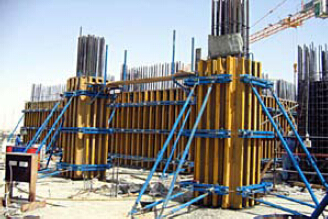
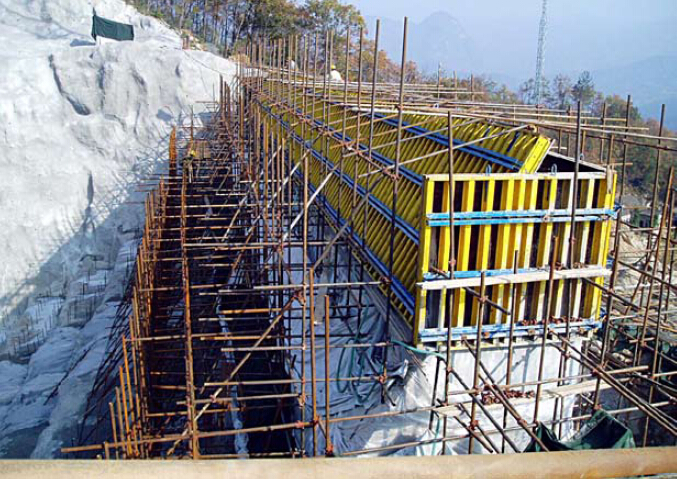
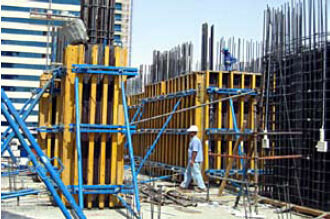
- Q: What are the different types of reinforcement systems used with steel formwork?
- There are several different types of reinforcement systems that are commonly used with steel formwork in construction projects. These systems are designed to provide additional strength and stability to the formwork, ensuring that it can withstand the weight of the concrete and other loads. One common type of reinforcement system is the use of steel bars or rods, also known as rebar. Rebar is typically placed horizontally and vertically within the formwork to create a grid-like structure. This helps to distribute the weight of the concrete evenly and prevent any potential cracks or failures in the formwork. Another type of reinforcement system is the use of wire mesh or welded wire fabric. This is a grid of wires that is typically laid over the formwork before the concrete is poured. The wire mesh helps to reinforce the concrete and provide additional strength and durability. In some cases, steel formwork may also incorporate precast concrete elements as reinforcement. These elements, such as precast beams or columns, are placed within the formwork to provide additional support and reinforcement to the structure. Additionally, some formwork systems may utilize post-tensioning techniques for reinforcement. This involves installing steel cables or bars within the formwork and then applying tension to them after the concrete has been poured. This helps to increase the strength and stability of the formwork and the overall structure. Overall, the choice of reinforcement system will depend on the specific requirements of the project, including the load capacity, design specifications, and desired level of durability. By using appropriate reinforcement systems, steel formwork can be made stronger and more reliable, ensuring the success and safety of the construction project.
- Q: How does steel formwork handle concrete curing time?
- Steel formwork handles concrete curing time in a highly efficient and effective manner. Steel formwork is constructed using sturdy and durable steel plates, which provide excellent support and stability during the pouring and curing process. The steel plates are designed to withstand the weight and pressure exerted by the wet concrete, ensuring that the formwork remains intact and in place until the concrete has fully cured. This prevents any deformation or collapse of the formwork structure, which could compromise the quality and integrity of the final concrete structure. Additionally, steel formwork has a smooth and non-absorbent surface, which minimizes the loss of moisture from the concrete during the curing process. This is crucial as maintaining proper moisture levels is essential for the concrete to achieve optimal strength and durability. Furthermore, steel formwork allows for easy and efficient removal once the concrete has cured. The steel plates can be easily dismantled and reassembled for subsequent concrete pours, reducing the overall construction time and cost. Overall, steel formwork provides a reliable and robust solution for handling concrete curing time. It ensures the structural integrity of the formwork during the curing process, maintains proper moisture levels for optimal concrete strength, and allows for efficient removal once the concrete has fully cured.
- Q: Can steel formwork be used for architectural concrete walls with complex geometries?
- Indeed, architectural concrete walls with complex geometries can indeed utilize steel formwork. The utilization of steel formwork bestows numerous advantages for such applications. Its remarkable durability enables it to withstand the force exerted by the concrete during the pouring and curing process. Additionally, steel formwork guarantees exceptional dimensional accuracy, ensuring that the concrete walls are constructed according to the desired complex geometries. Furthermore, steel formwork facilitates effortless customization and design flexibility. It can be effortlessly fabricated into a plethora of shapes and sizes, thereby empowering architects to create intricate and distinctive architectural concrete walls. Moreover, steel formwork endows the concrete with a smooth and uniform finish, resulting in visually pleasing walls. Moreover, steel formwork boasts reusability, thus rendering it a cost-effective choice for projects involving complex geometries. It can be disassembled and utilized for multiple projects, thereby reducing overall construction expenses. The ease of cleaning and maintenance of steel formwork further enhances its usability and longevity. To conclude, steel formwork emerges as an optimal selection for architectural concrete walls with complex geometries. It provides strength, durability, dimensional accuracy, customization options, and cost-effectiveness, thus making it a suitable solution for constructing visually appealing and structurally sound concrete walls.
- Q: Can steel formwork be used for both above-water and underwater structures?
- Steel formwork can be utilized for both structures above the water surface and those submerged underwater. Its strength and durability have earned it a reputation suitable for a wide range of construction projects. When employed for structures above the water, steel formwork acts as a robust and dependable support system for casting concrete, guaranteeing the desired shape and finish are achieved. Furthermore, steel formwork is commonly employed for underwater structures due to its ability to endure the harsh conditions and pressures associated with submersion. It is engineered to be watertight and resistant to corrosion, enabling its use in casting concrete underwater. This ensures the concrete is shaped and cured correctly, resulting in structurally sound underwater constructions. In addition to its strength and durability, steel formwork also provides several advantages for both structures above the water and underwater. It is reusable, reducing construction costs and minimizing environmental impact. Moreover, steel formwork is versatile, accommodating flexible designs and adapting to diverse project requirements. Nevertheless, it is crucial to consider the specific requirements and conditions of each project when determining the suitability of steel formwork for a particular application. Factors such as water pressure, water quality, and the presence of corrosive substances should be carefully evaluated to ensure the longevity and effectiveness of the steel formwork in both structures above the water and underwater.
- Q: What is the maintenance required for steel formwork?
- To maintain steel formwork, cleaning and storage are of utmost importance. After each use, it is crucial to thoroughly clean the formwork to eliminate any concrete residue or debris. This can be accomplished by employing water and a brush or pressure washer. Additionally, any signs of rust should be addressed with a rust converter and a coat of paint to prevent further deterioration. Proper storage plays a vital role in maintaining steel formwork. It should be kept in a dry and well-ventilated area to prevent the accumulation of moisture and subsequent rusting. If feasible, storing the formwork above ground level will minimize contact with moisture. To ensure the formwork remains in optimal working condition, regular inspections should be conducted to detect any damages or signs of wear and tear. Any bent or damaged components should be promptly repaired or replaced. In summary, maintaining steel formwork entails regular cleaning, appropriate storage, and thorough inspections to guarantee its longevity and effectiveness in construction projects.
- Q: How does steel formwork contribute to the overall constructability of the project?
- Steel formwork plays a crucial role in construction projects, contributing significantly to the overall constructability. Its importance can be seen in various aspects of the construction process. To begin with, the strength and durability of steel formwork allow it to withstand the pressure exerted by concrete during pouring. This strength ensures that the formwork remains intact, enabling the construction of structures with complex shapes and designs. It also allows for the use of thicker and heavier concrete, resulting in stronger and more durable structures. Furthermore, steel formwork provides accuracy and precision in shaping concrete structures. Its rigid structure and dimensional stability allow for consistent and uniform concrete placement, ensuring that the final product meets the desired specifications. This accuracy is crucial for achieving the desired aesthetic and functional outcome of the project. In addition, steel formwork offers versatility and adaptability. It can be easily modified, adjusted, and reused for different projects, making it a cost-effective option. This flexibility is particularly useful when changes or modifications need to be made during the construction process. The ability to quickly adapt the formwork saves time, reduces material wastage, and enhances overall project efficiency. Moreover, steel formwork improves construction speed. Its strength and stability allow for faster concrete pouring and setting times. This expedited construction process reduces project timelines, resulting in cost savings and increased productivity. Another important contribution of steel formwork is its enhanced safety features. It is designed with safety in mind, incorporating handrails, access platforms, and non-slip surfaces. These features provide a safe working environment for construction workers, reducing the risk of accidents and injuries. In conclusion, steel formwork significantly contributes to the overall constructability of a project through its strength, accuracy, versatility, speed, and safety features. Its ability to withstand extreme loads, provide precise shaping, adapt to changes, expedite construction, and enhance safety make it an invaluable component in construction projects.
- Q: Can steel formwork be used for earthquake-resistant concrete buildings?
- Yes, steel formwork can be used for earthquake-resistant concrete buildings. Steel formwork refers to the temporary structure used to hold and shape the concrete until it sets and hardens. It is known for its strength, durability, and ability to withstand high loads, which are desirable characteristics in earthquake-resistant construction. During an earthquake, buildings are subjected to lateral forces and vibrations. Steel formwork, being strong and rigid, can help in distributing and transferring these forces throughout the structure. It provides the necessary support to ensure the concrete walls, columns, and slabs remain intact during seismic events. Additionally, steel formwork allows for precision and accuracy during the construction process. This is crucial in earthquake-resistant buildings as any deviation from the intended design can weaken the structure's ability to withstand seismic forces. The use of steel formwork ensures that the concrete components are properly reinforced with steel bars and that all necessary connections and joints are correctly placed. Furthermore, steel formwork can be easily assembled, disassembled, and reused, making it a cost-effective solution for earthquake-resistant construction projects. This allows for efficient construction practices, reduces waste, and enables the formwork to be used for multiple projects, making it an environmentally friendly choice. However, it is important to note that while steel formwork is an essential component in earthquake-resistant concrete buildings, it is not the only factor that determines the overall structural integrity. Other design considerations such as proper reinforcement detailing, adequate foundation design, and appropriate structural analysis are equally important. In conclusion, steel formwork can be effectively used for earthquake-resistant concrete buildings due to its strength, durability, and ability to withstand seismic forces. However, it should be complemented with proper design and construction practices to ensure the overall structural resilience and safety of the building.
- Q: Can steel formwork be used in areas with limited labor availability?
- Yes, steel formwork can be used in areas with limited labor availability. Steel formwork is a versatile and durable system that requires less labor compared to traditional formwork methods. It is easy to assemble and disassemble, and can be reused multiple times, reducing the need for continuous labor for formwork construction. Additionally, steel formwork is lightweight and can be easily transported to remote areas, making it suitable for construction projects in locations with limited labor resources. Overall, the use of steel formwork can help streamline the construction process and optimize labor usage in areas with limited labor availability.
- Q: What are the different accessories required for steel formwork maintenance?
- Some of the different accessories required for steel formwork maintenance include formwork release agents, cleaning solutions, wire brushes, repair materials such as epoxy or cementitious grout, lubricants for hinges and pins, and protective coatings for corrosion prevention. Additionally, tools such as hammers, wrenches, and pliers may be needed for minor repairs or adjustments.
- Q: Are there any specific considerations for using steel formwork in areas with limited power supply?
- Yes, there are several specific considerations for using steel formwork in areas with limited power supply. Firstly, since steel formwork requires power tools for installation and removal, alternative methods such as manual labor or non-powered equipment may need to be employed. Additionally, the limited power supply may affect the availability of electricity for welding, which is often required for steel formwork assembly. Therefore, alternative joining methods such as bolting or mechanical fastening may need to be explored. Finally, the transportation and storage of steel formwork components in areas with limited power supply may require additional planning to ensure their accessibility and protection.
Send your message to us
Timber-Beam Formwork for building Construction
- Loading Port:
- Tianjin
- Payment Terms:
- TT OR LC
- Min Order Qty:
- 50 m²
- Supply Capability:
- 1000 m²/month
OKorder Service Pledge
Quality Product, Order Online Tracking, Timely Delivery
OKorder Financial Service
Credit Rating, Credit Services, Credit Purchasing
Similar products
Hot products
Hot Searches
